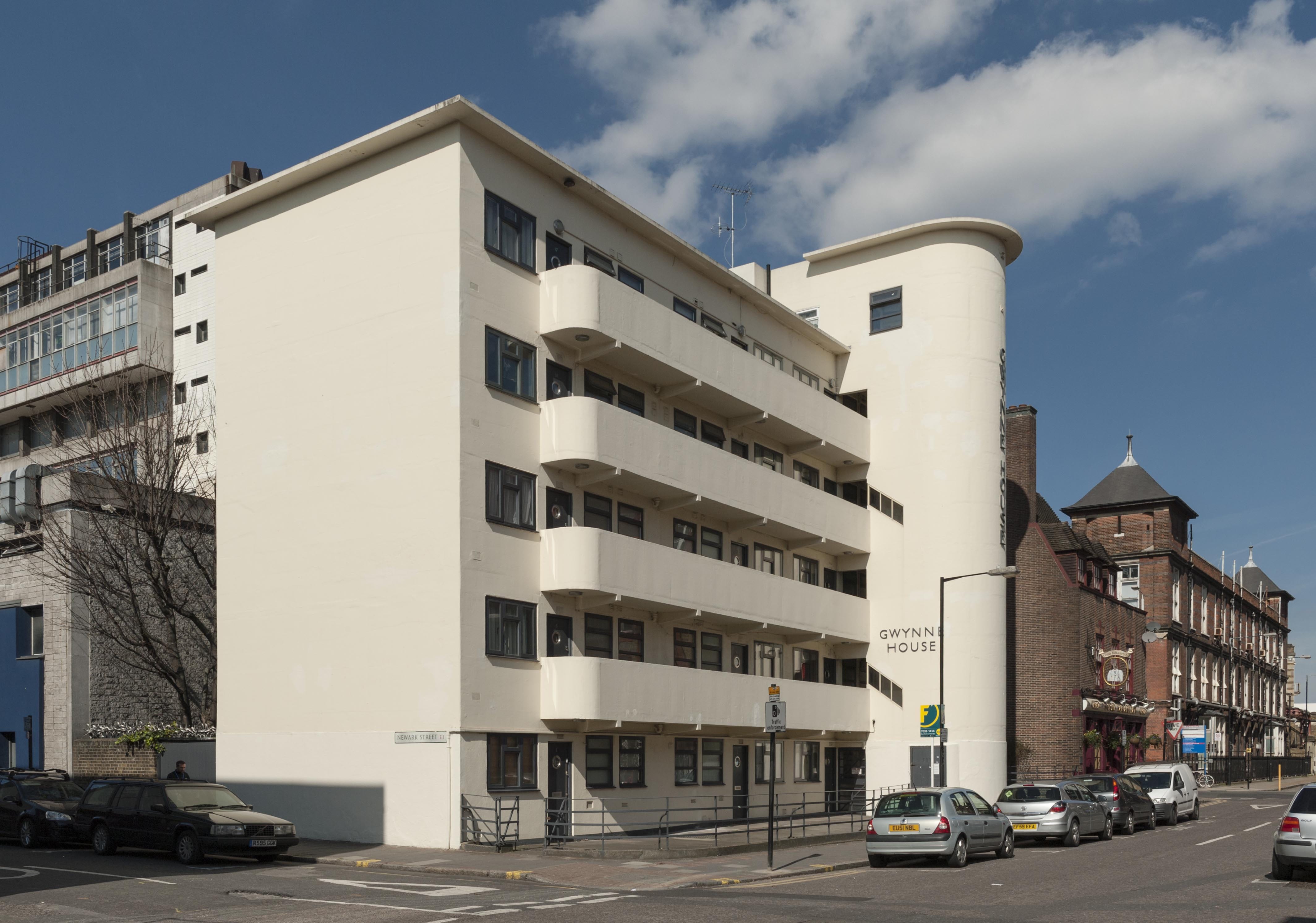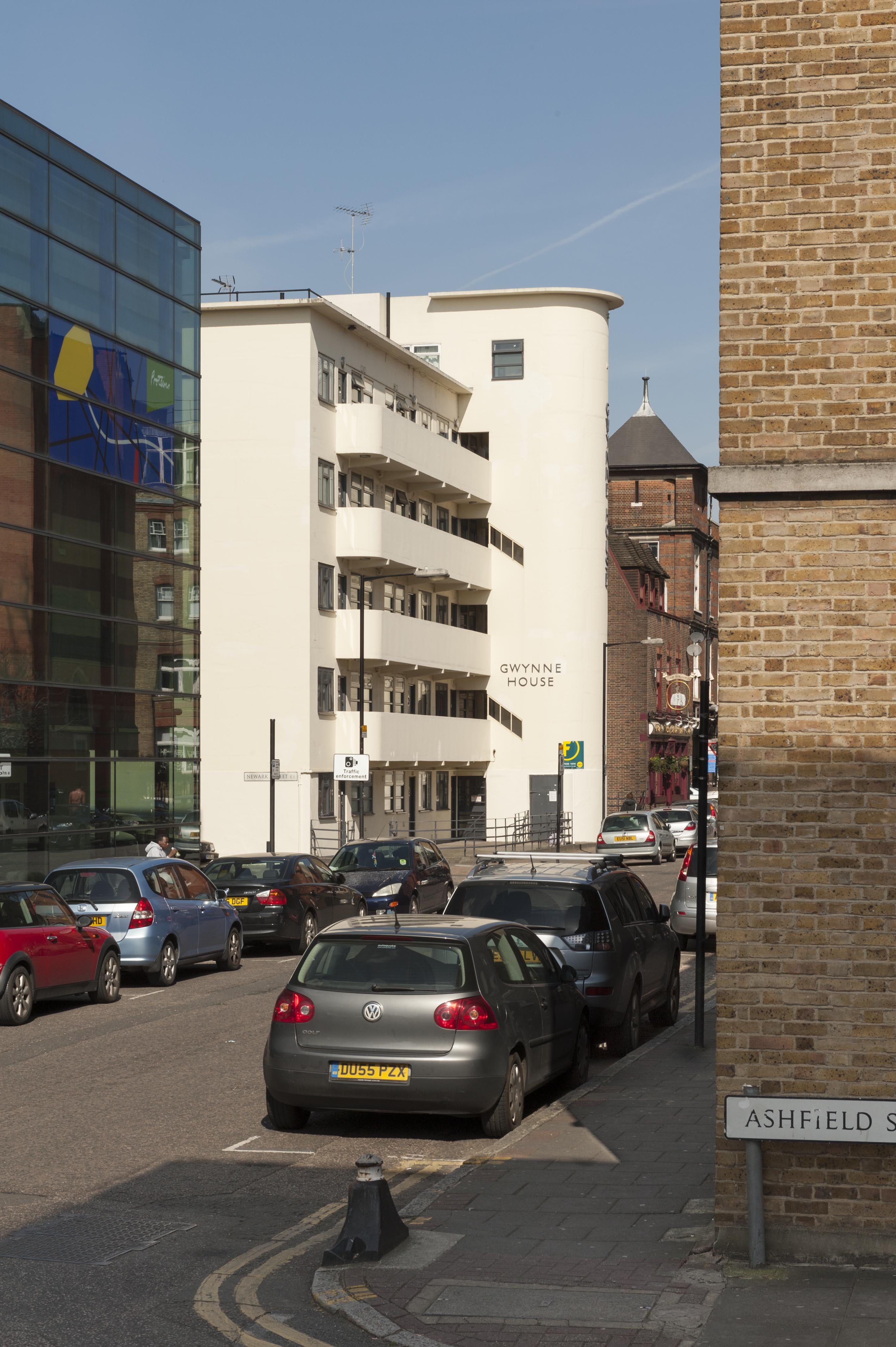Gwynne House, Turner Street
By the Survey of London, on 9 June 2017
Gwynne House stands at the north-west corner of the Turner Street and Newark Street crossing in bold contrast to its contemporary neo-Georgian neighbour, the Good Samaritan public house. This block of flats was built in 1937–8 to designs by H. Victor Kerr, the architect of a number of interwar buildings in east London, including Commerce and Industry House in Middlesex Street (demolished), 67–75 and 101 New Road, 9–17 Turner Street and 47 Turner Street (demolished). While there is no known professional association between Kerr and the London Hospital, his designs repeatedly found favour on its Whitechapel estate. Kerr practised as an architect during the interlude in his military career between the world wars, in which he ascended to the rank of Major (Hon. Lt. Col.). Of his surviving works in Whitechapel, Gwynne House is the most assertive expression of the Modernist style. This five-storey block has a sleek white-painted façade with a curved staircase tower and a rhythmic succession of slender balconies with rounded edges. Gwynne House bears a resemblance to Wells Coates’s Isokon Building, which set a precedent in style, configuration, and the provision of ‘minimum’ flats intended for professionals.

Gwynne House and the Good Samaritan Public House from the north-east in 2016. Gwynne House was built in 1937–8 to designs by H. Victor Kerr. © Derek Kendall
Gwynne House replaced five early nineteenth-century terraced houses at 75–83 Turner Street and 23a Newark Street on the London Hospital Estate. By the 1930s this piece of ground had been earmarked for future hospital expansion. Despite initial reluctance to part with the site, the hospital agreed an 80-year lease with Lloyd Rakusen & Co. of Leeds in 1935. After their plans to build a biscuit factory were rejected by the LCC, Rakusen & Co.’s interest in the lease was transferred to a developer for a block of flats. Construction was by Moore & Wood, working as general contractors in association with specialized subcontractors. The reinforced concrete frame was enveloped by smooth external walls filled with cork insulation, and capped with a flat timber roof coated with asphalt. At its completion in 1938, Gwynne House provided twenty modern flats that were designed to attract ‘students, social workers and professional people in east London’. An additional rooftop flat was allocated to a caretaker. Each floor was divided into four small flats built to a standardised rectangular plan with a hallway, two bedrooms, a living room, a kitchenette and a bathroom. The elegant ‘tower feature’ encased an electric lift and a staircase, lit and ventilated by angular slits in the exterior wall. It also concealed a rubbish chute, a telephone kiosk, a switch room, and service ducts that communicated with a basement boiler room. [1]

Gwynne House from the south-east in 2016. © Derek Kendall
Gwynne House was quickly identified by the hospital as a convenient base for medical practitioners, nurses and students, though rents were judged to be ‘somewhat high’. [2] One of its first tenants was a young (Sir) John Ellis, who was later appointed physician to the London Hospital and Dean of the Medical College. Other prominent residents included Edith Ramsay MBE, a local social campaigner, and the nurse educationalist Dr Sheila Collins OBE. By the 1980s Gwynne House had been acquired for the hospital as rented accommodation for staff from all departments. Barts and the London Charity sold the block to a private developer in 2011. The exterior has seen minimal alterations, aside from the replacement of the original Crittall windows and the recent insertion of jaunty porthole doors. The original metal fence at the front of the block survives, characterised by sinuous lines echoing the projection of the tower. A narrow rear garden shelters a sycamore tree, a lime tree, and an ‘ancient’ mulberry tree. [3]

Gwynne House in 2016. © Derek Kendall
Do you have any memories of Gwynne House? The Survey of London has launched a collaborative website titled ‘Histories of Whitechapel’ and welcomes contributions. Please visit at https://surveyoflondon.org.
References
- The Builder (19 May 1939), p. 948.
- Royal London Hospital Archives (RLHA), RLHLH/A/5/64, p. 209.
- The Gentle Author, ‘The Whitechapel Mulberry’, Spitalfields Life, 30 March 2015 (online: http://spitalfieldslife.com/2015/04/30/the-whitechapel-mulberry).
 Close
Close


